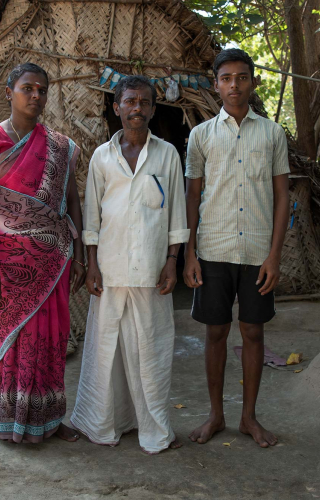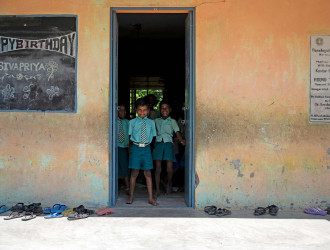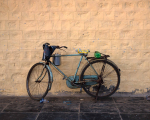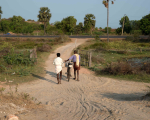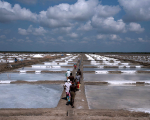In 2017, while doing my journalism course in Chennai, our professor showed us an award-winning documentary made by Farida Pacha—My Name is Salt. The documentary is based on the life of a salt harvester, Sanabhai, who toils year-after-year in the inhospitable terrain of the Little Rann of Kutch to produce what he claims to be the world’s whitest salt. The documentary sparked my interest. Although Gujarat produces 75 per cent of the salt in India, my professor informed me of a similar saline landscape in Tamil Nadu that also contributes to the salt production in India.
Salt is harvested in three districts in Tamil Nadu: Marakkanam in Villupuram, and further south on the Coromandel Coast in Tuticorin and Nagapattinam. Salt harvesting employs about 60,000 workers, mostly unskilled and seasonal, and a majority of them women. Tamil Nadu has more than 40,000 acres of salt pans, partly owned by the central government, while the remaining belong to the state government, port trust authority or are licensed privately.
While breezing through the East Coast Road, through Tamil Nadu, I was fascinated by the mounds of glistening white pyramids of salt lining the highway, spread over 2,500 acres of coastal land. Though the salt pans look spectacular, working in the pans involve backbreaking labour. There are around a dozen villages in Marakkanam, all engaged in salt production. I visited the small hamlet of Naravakkam, where almost every family is involved in working at the salt pans.
Initially, the workers were shy to interact with me since they were not used to outsiders amongst them. They would often try to initiate a conversation with me, to which I promptly replied with ‘Tamil teriada’ (I don’t know Tamil). Aided by a local translator, I could finally communicate with them. Usually, salt production in the region goes on for eight or nine months a year—starting from January till August or September. Peak production is reached between the months of April and June when the skies are clear and the sun is strong. Workers start work around 6 am, reaching the salt pans either on foot or on cycle. The process itself is rather simple and involves little infrastructure, power or machinery. The salt pans are cleaned, before sea water is pumped through a network of pipes. The brine is left to evaporate in the pans for three or four days, after which the salt crystals are dredged with long rakes. They are collected, dried in the sun, packed in gunny bags and transported to godowns from where they are distributed to markets across Tamil Nadu.
As I walked over the levees, my shoes sank into the soft mud. Walking barefoot was the only option, like the hundreds of workers working there. No one wears any footwear. The razor-sharp salt crystals leave the workers with scared soles and palms, but they ignore the burning pain and continue working because the wages are paid on a daily basis, and they cannot afford to take medical leave for which they would receive no compensation. ‘Every minute lost means less salt collected, which means less money paid by the contractor,’ I am told.
Even the wages are not equal. Men get paid three times the amount for doing the same work as women. Women are further vulnerable because there are no sanitation facilities for them. They have to relieve themselves in the open. In order to avoid frequent toilet breaks, they restrict water consumption. Due to this, many suffer acute dehydration and dizziness. In addition, this has given rise to various gynaecological complications ranging from kidney diseases to urinary tract infections. The workers are not provided with any medical care facilities or protective equipment by their employer. Many workers here have been working for decades, and long-term exposure to salt and sunlight has given rise to a multitude of diseases like dental caries, dermatitis, thickening of sole and palm, goitre and anaemia. Due to exposure to harsh sunlight reflected from the white salt, labourers suffer from a variety of eyesight problems as well, like cataract,pterygium, conjunctivitis, pingecula and corneal ulcer. Many are diagnosed with glaucoma at an early age. Health problems get more acute as the worker gets older.
Salt production is suspended during the monsoon months (September to December) when the salt pans remain inundated. During this lull, labourers retire to their villages to engage in agriculture or find some temporary work. This leaves them with almost no income for a third of the year. Therefore, the annual household income of a salt pan worker is extremely low, making them heavily reliant on local moneylenders.
The families I met were acutely aware of their lack of social mobility due to a lack of education and infrastructure. They hope that they can educate their children enough so the children don’t have to struggle like they did. One of the pertinent issues which the industry is bound to face in the coming years is the lack of skilled labour. Government policy changes in recent times have added further hardship. The central government has refused to renew expired licenses and instead will give them to highest bidders after every 20 years. Since this policy change, 80 salt manufacturers have stopped production while many others have gone to court. This has deprived Tamil Nadu of its salt self-reliance and the state now has to import the deficit from Gujarat.
The visit to Marakkanam made me realise how a simple product like salt, which we take for granted, takes so much intensive labour to produce. India is the third highest salt producing country in the world, yet the workers remain uncared for and socially backward. The children of salt pan workers are moving out to big cities in search of better jobs. I barely met any worker who in their 20s, most are in their 40s or 50s. The questions that comes to my mind are—Who will replace them in the future? How will India sustain its salt production for an increasing population as more and more workers move away from working in the salt pans?
